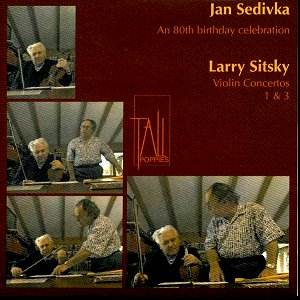Though Larry Sitsky’s Violin Concertos are the focus
of interest of this disc from a repertoire point of view, the name
that first adorns the CD is that of the soloist and dedicatee of
the works, the Czech born violinist Jan Sedivka. It was issued to
time with his 80th birthday back in 1998 – though the
recordings date from 1974 (No. 1) and 1992 (No. 3). So a word about
Sedivka. He was a pupil of Kocian and Ševčik
and afterwards of Thibaud in Paris. His travels across Europe led
to London where he took further studies with Max Rostal and began
to forge a noted career. He was a teacher at Trinity and Goldsmiths
amongst others and had a London International Trio with whom
he premiered some chamber works by Alan Bush. He left for Australia
in 1961 settling in Tasmania where he became Director of the Conservatoire
and inspired a host of new work for his instrument from amongst
others Colin Brumby, Edward Cowie, Eric Gross and Sitsky. I first
came across Sedivka’s name when I found a BBC Transcription recording
he’d made with pianist Ruth Bauerova of Emil Axman’s Violin Sonata.
Axman’s was hardly a big name – then or now – but I was intrigued
and the performance is a good one. All this shows at least that
Sedivka has always been a questing and adventurous musician, with
a wide range of interests generally and ambitious for the future
repertoire of the violin.
Larry Sitsky has dedicated his Violin Concertos
Nos. 1, 2, 3 and 4 to Sedivka, a good friend. The first in 1972
takes Kepler’s Mysterium Cosmographicum as its sub-title
and poetic force. The musical material is derived from Busoni’s
Faust – taking chordal progressions and other material - and is
cast in five movements lasting thirty-six minutes. Doubtless Sitsky’s
immersion in Busoni’s music, which does lend an impressionistic
tint to it, in part derives from his studies with Busoni’s great
pupil and propagandist, Egon Petri. The Concerto opens with an
elusively complex violin cadenza, which forms the introduction.
Sitsky’s scoring should be noted, as the violins and violas don’t
make their appearance until towards the end of the work. Sitsky
employs a battery of percussion at climactic moments and some
driving lower string writing; the texture can also be eruptive
and violent but there is also real lyrical expression here, albeit
one with a keen edge to it. The central movement is slow and glinting
(Harmonicus is the title Sitsky gives to it) with shafts
of light flecking the score. In the final panel the chorus sings
the titles of each movement before a return to the opening material
via the agency of the soloist.
The Third Concerto (1987) is much more gently
scored and was inspired by the I Ching. Thus the work is divided
into eight sections – Water, Wind, Mountain and so on – and all
are quite short, unified by the all-embracing theme. Sitsky, who
was born in China but left when he was sixteen, attempts here
to evoke the sound of Chinese music but not to replicate it; his
approach is mystical and spiritual. Technically he makes use of
the so-called Chinese string portamento with accompanying percussive
support. Rhythmically there is plenty of dance material – as in
the second movement Wind, a dance that is skittish and accompanied
by a truly impressive Chinese brass section. There is an eternal
horizon feel to Mountain and a brassy enveloping in the nocturnal
Mist (that picks up the brass motif from Wind). Sitsky evokes
these elements of Chinese music with great sensitivity and timbral
and rhythmic intricacy. I particularly enjoyed the propulsively
percussive writing in Heaven, a moto perpetuo, and the contemplative
and elliptical Fire. Fittingly Earth explores the registral depth
of the bass and the height of the flute in its encompassing wholeness.
Throughout, Sedivka is a protagonist and interweaver
of distinction; he mediates between Sitsky’s elevated vision and
the violin’s technical realities with perfect judgement. The recordings
sound very well indeed and the notes are not too florid; just
right, in fact.
Jonathan Woolf

